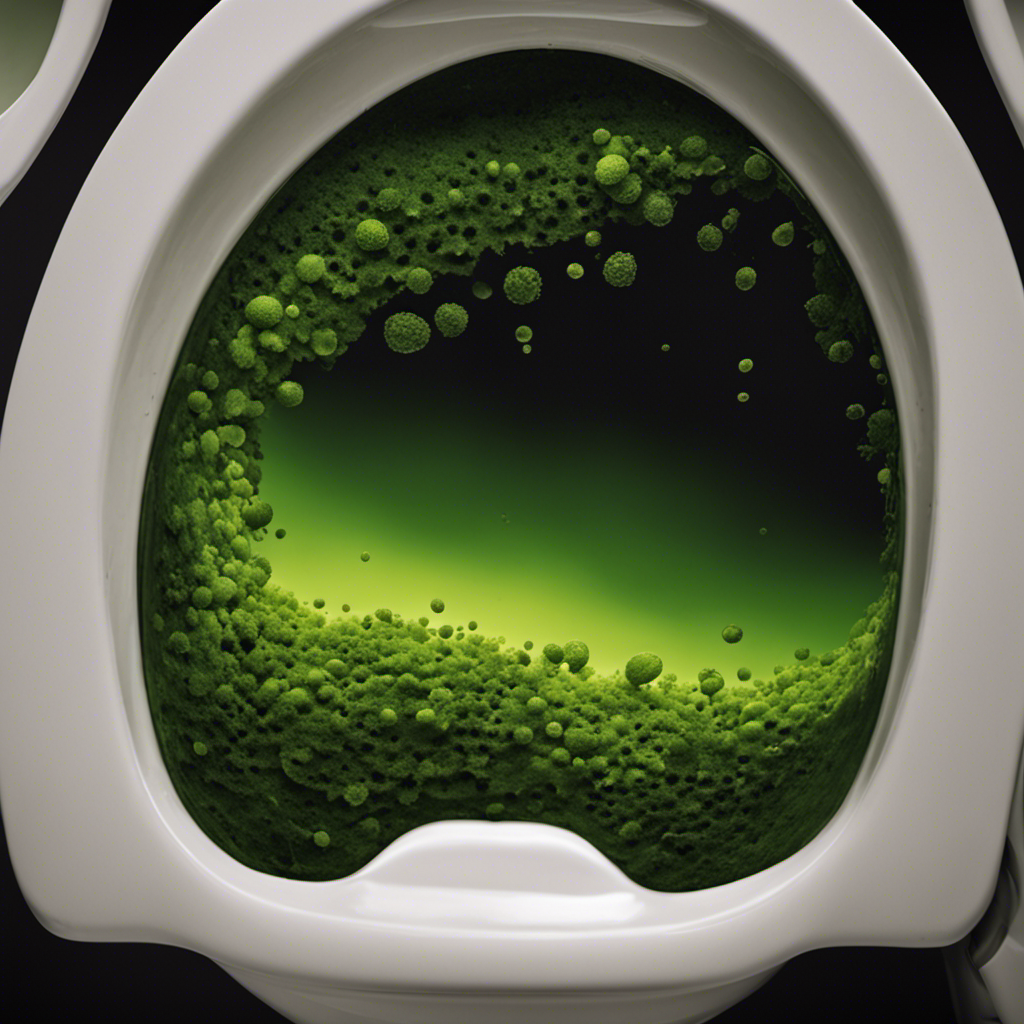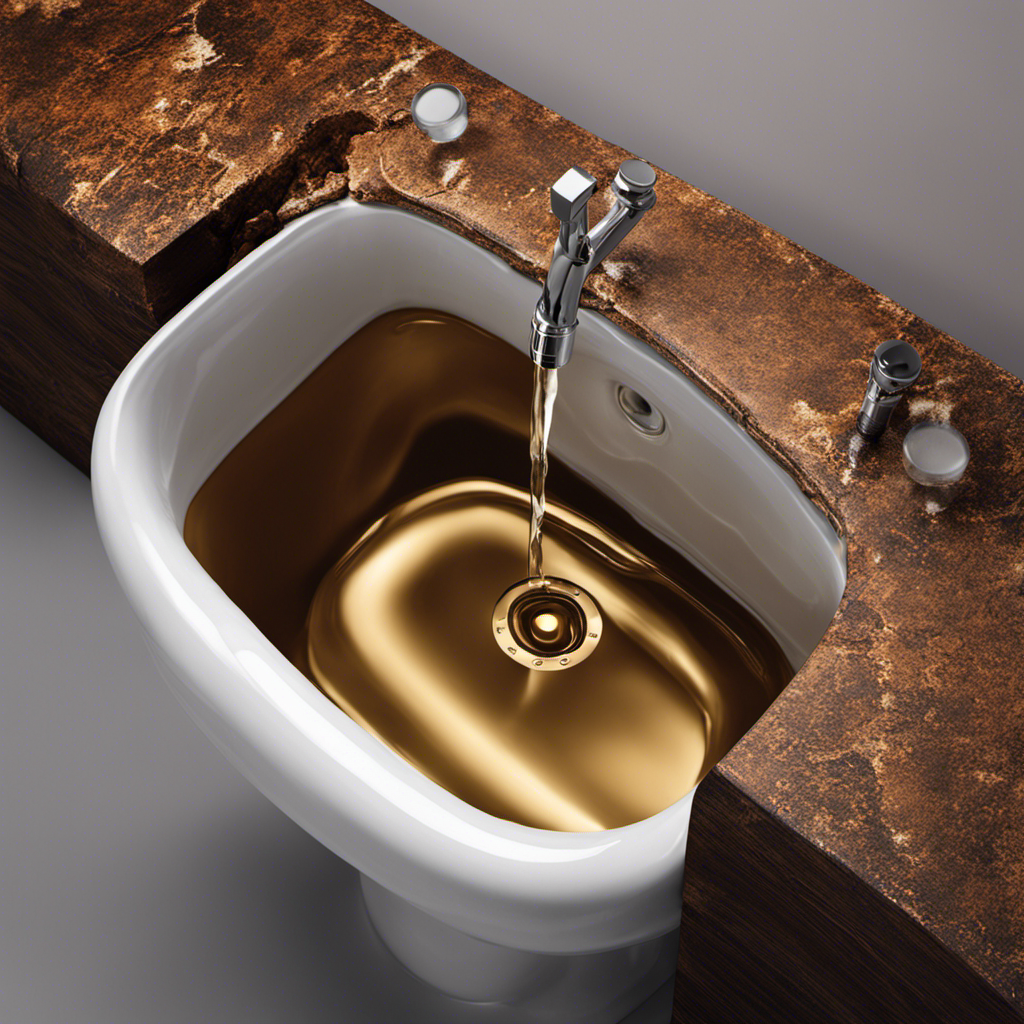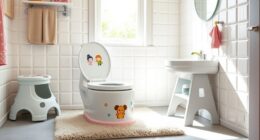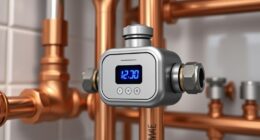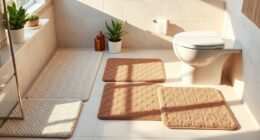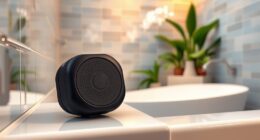I’ve always wondered why there’s mold growing in my toilet. It’s frustrating and unsightly, but understanding the causes is crucial in preventing its recurrence.
In this article, we’ll delve into the role of humidity in mold growth, identify common toilet mold species, and explore effective prevention methods.
We’ll also address plumbing issues that may contribute to mold growth and highlight the importance of proper ventilation.
By the end, you’ll have the knowledge to confidently clean and remove mold from your toilet.
Key Takeaways
- Moisture and poor ventilation are common causes of toilet mold growth.
- Regular cleaning with disinfectants and mold-resistant cleaners can prevent mold growth.
- Mold thrives in high humidity and temperature environments, so it’s important to control these factors.
- Mold can cause respiratory issues, skin irritation, and infections, so prompt mold removal is necessary for a healthy living environment.
Understanding the Causes of Toilet Mold
You might be wondering why mold is growing in your toilet. Toilet mold can be caused by a variety of factors, but the most common culprits are moisture and poor ventilation.
Mold thrives in damp environments, and toilets provide the perfect breeding ground. To prevent toilet mold, it is important to keep the area dry and well-ventilated. Make sure to fix any leaks or plumbing issues promptly to prevent excess moisture.
Regularly cleaning your toilet with a disinfectant can also help prevent mold growth. If you already have mold in your toilet, it is crucial to remove it as soon as possible. Use a mixture of bleach and water to scrub away the mold, and make sure to wear protective gloves and a mask.
The Role of Humidity in Mold Growth
The role of humidity in mold growth can be seen in the moist environment of a bathroom. Mold thrives in areas with high levels of moisture, making bathrooms, particularly the toilet area, a prime breeding ground. But it’s not just humidity that plays a role in mold growth; temperature also has an impact. Mold tends to thrive in temperatures between 77-86 degrees Fahrenheit. Combine this with high moisture levels, and you have the perfect conditions for mold growth. To better understand the relationship between humidity, temperature, and mold growth, take a look at the table below:
| Humidity Level | Temperature Range | Mold Growth Potential |
|---|---|---|
| High | 77-86°F | High |
| High | Below 77°F | Low |
| Low | 77-86°F | Low |
| Low | Below 77°F | Low |
| Moderate | 77-86°F | Moderate |
Identifying Common Toilet Mold Species
To identify common toilet mold species, it’s important to carefully observe the color, texture, and location of the growth.
Common toilet mold symptoms include the presence of dark patches or spots in various colors, such as black, green, or brown. The texture of the mold can vary from fuzzy and velvety to slimy or powdery.
It’s crucial to note the location of the mold in bathroom fixtures, as certain species prefer specific environments. For instance, black mold, or Stachybotrys chartarum, thrives in damp and humid areas, often found in toilets with poor ventilation.
On the other hand, green mold, or Aspergillus, can be commonly found on bathroom tiles or grout.
Effectively Preventing Mold in the Toilet
By regularly cleaning and disinfecting your toilet, you can effectively prevent the growth of mold. Mold growth in toilets is a common problem that can lead to health issues and unpleasant odors.
To prevent mold from taking hold, it is important to adopt effective cleaning techniques. Start by using a toilet bowl cleaner that contains bleach or another disinfectant. Scrub the inside of the bowl with a toilet brush to remove any visible stains or build-up. Don’t forget to clean under the rim and around the edges of the bowl. After cleaning, flush the toilet to rinse away any remaining residue.
Additionally, it is recommended to clean the toilet at least once a week to maintain a mold-free environment.
Addressing Plumbing Issues to Combat Mold
As an expert in plumbing, I want to address the issue of leak detection methods and preventing future mold growth.
When it comes to leak detection, it is crucial to utilize advanced technologies such as thermal imaging cameras and moisture meters to pinpoint the exact location of leaks. By promptly identifying and repairing leaks, we can effectively prevent moisture buildup and subsequent mold growth, ensuring a healthier and safer living environment.
Additionally, implementing preventive measures such as regular inspections, proper ventilation, and moisture control techniques can significantly reduce the likelihood of mold formation in the future.
Leak Detection Methods
One of the most effective methods for detecting leaks is by using a water meter. A water meter can accurately measure the flow of water in your plumbing system, allowing you to identify any abnormal water usage that may indicate a leak.
To detect leaks using a water meter, start by turning off all water-consuming appliances and fixtures in your home. Then, take note of the meter reading. Wait for a few hours without using any water and check the meter again. If the reading has increased, it indicates a possible leak.
Once a leak is detected, it is crucial to address it promptly to prevent further damage and the growth of mold. Mold removal techniques should be employed to eliminate any existing mold and prevent its recurrence.
Preventing Future Mold
To prevent future mold growth, it’s crucial to regularly inspect and repair any leaks in your plumbing system. Mold thrives in damp environments, so addressing sources of moisture in your home is essential. Here are some long-term solutions to help prevent future mold:
- Ensure proper ventilation in your bathroom by using exhaust fans or opening windows.
- Keep humidity levels low by using dehumidifiers or air conditioners.
- Clean and dry any water spills or leaks immediately to prevent mold from developing.
By implementing these preventive measures, you can significantly reduce the risk of mold growth in your toilet and other areas of your home.
The Importance of Proper Ventilation in Mold Prevention
If you don’t have proper ventilation, mold can easily grow in your toilet. Proper ventilation is crucial in preventing mold growth and maintaining a healthy environment in your bathroom.
A well-functioning ventilation system helps to remove excess moisture and odors from the air, reducing the conditions that promote mold growth. By ensuring that your ventilation system is properly maintained, you can reap a range of benefits.
Firstly, it helps to prevent the accumulation of moisture, which is a key factor in mold growth. Secondly, it helps to improve air quality by removing unpleasant odors and potentially harmful pollutants. Lastly, a well-maintained ventilation system can also help to prevent structural damage to your bathroom caused by excessive moisture.
Regularly cleaning and inspecting your ventilation system is essential to ensure its optimal performance and effectiveness in mold prevention.
Cleaning and Removing Mold From the Toilet
When it comes to preventing mold in your toilet, there are several key tips to keep in mind.
Firstly, ensure that the bathroom is well-ventilated, as mold thrives in moist and humid environments.
Secondly, regularly clean and disinfect your toilet using the best cleaning products specifically designed to eliminate mold.
Lastly, it is crucial to be aware of the health risks associated with mold exposure, such as respiratory issues and allergies, and take necessary precautions to protect yourself and your family.
Prevention Tips for Mold
You can easily prevent mold growth in your toilet by regularly cleaning it with a mixture of vinegar and water. Mold thrives in moist environments, so it’s important to keep your toilet clean and dry.
Here are some key factors to consider for toilet mold prevention:
- Proper ventilation: Make sure your bathroom has good ventilation to reduce humidity levels.
- Regular cleaning: Clean your toilet at least once a week to remove any potential mold spores.
- Use a mold-resistant cleaner: Look for cleaning products specifically designed to prevent mold growth.
By following these preventive measures, you can significantly reduce the chances of mold growth in your toilet.
However, if you already have mold in your toilet, it’s essential to take immediate action to remove it. In the next section, we will discuss the best cleaning products for effectively eliminating mold from your toilet.
Best Cleaning Products
To effectively eliminate mold from your toilet, consider using cleaning products specifically designed to prevent its growth. Mold thrives in damp and dark environments, making the toilet bowl a perfect breeding ground.
The best cleaning technique for removing mold is to use a solution containing bleach or hydrogen peroxide. These powerful disinfectants kill mold spores and prevent their regrowth.
Alternatively, natural cleaning alternatives like vinegar or tea tree oil can be used. These natural substances have antimicrobial properties that can also effectively eliminate mold. However, it is important to note that natural cleaning alternatives may not be as potent as commercial cleaning products.
Therefore, for the best results, it is recommended to use a combination of both techniques – starting with a commercial cleaning product, followed by regular maintenance with natural alternatives.
Health Risks Associated
As we discussed earlier, using the best cleaning products is essential for effectively removing mold from your toilet. However, it is important to understand the health risks associated with mold growth in order to prioritize its removal.
Mold can have several detrimental effects on our health, including respiratory issues such as allergies, asthma, and other respiratory problems. It can also cause skin irritation, leading to rashes and irritation. In addition, certain types of mold can cause infections in individuals with weakened immune systems.
To ensure a healthy living environment, it is crucial to employ proper mold removal techniques. These techniques may include using bleach or specialized mold removal products, scrubbing the affected area with a brush or sponge, and ensuring proper ventilation to prevent moisture buildup and mold growth.
Conclusion
In conclusion, mold growth in your toilet can be a frustrating and unsightly problem. By understanding the causes of mold, such as high humidity and plumbing issues, and taking preventative measures like proper ventilation and regular cleaning, you can effectively combat this issue.
Remember, a mold-free toilet not only ensures a clean and healthy environment but also saves you from costly repairs in the long run.
So, take charge and say goodbye to mold in your toilet for good!
